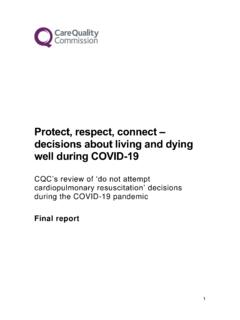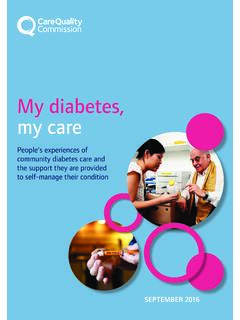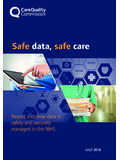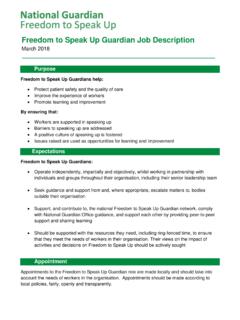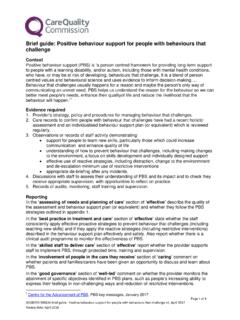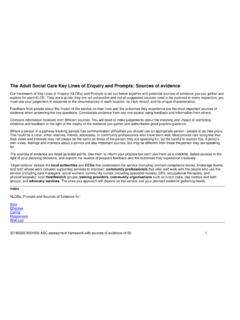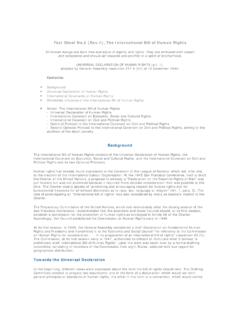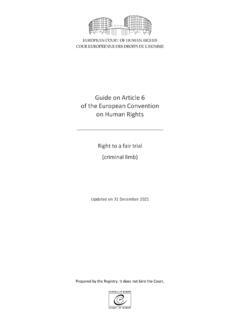Transcription of CQC Human rights approach
1 YOur Human rights approach for how weregulate health and social care services: February2019 Page 2 About the Care Quality Commission Our purposeThe Care Quality Commission is the independent regulator of health and adult social care in England. We make sure that health and social care servicesprovide people with safe, effective, compassionate, high-quality care and we encourage care services to improve. Our roleWe register health and adult social care providers. We monitorandinspect services to see whether that are safe, effective, care, responsive, and well-led, andwe publish what we find, including values Excellence being a high-performing organisation Caring treating everyone with dignity and respect Integrity doing the right thing Teamwork learning from each other to be the best we can A summary of this document is also available from the CQC website feedback on our of findings: our 2018 review of the do we need a Human rights approach ?.. do we mean by Human rights ?.
2 Definitions of our Human rights Policy Relationship with the Human rights Act Relationship with the Equality Act Relationship with UN Conventions on Human Human rights into assessment our Human rights approach to our Considering Human rights in Monitoring risk to Human Inspecting for Human Building confidence in Human rights : learning, developing and empowering CQC staff to take Communicating our approach to Human for applying our Human rights improvement and independent 4 BackgroundMany of the major pushes for change in CQC have been related to Human rights , such as Mid Staffordshire and Winterbourne View. We identified the need to embed a Human rights approach to our regulation in developingour strategy for 2013-2016, Raising standards, putting people first. Ourhuman rightsapproach was first published in 2014, alongside this strategy. Since then, we have delivered much regulatory work onequality and Human rights and developed how wedeliver individual elements of the approach , sometimes following evaluation exercises.
3 We now havean approach to Human rights which iswell-regarded across the sector and wehave gained experience to help us take effective action. For example, the recent Learning disability improvement standards produced by NHS Improvement states: CQC has embedded a Human rights -based approach in its regulatory framework since 2014, this has been a powerful driver for change in trusts. However, we have not reflectedon the overall Human rights approachsince itwasestablishedin 2014. We know that Human rights are still being breached in health and care settings. We know that there are still longstanding inequalities in access, experience andoutcomes for people using health and social care services. There have been significant changes in CQC since the Human rights approach was introduced. We are now delivering our second strategy Shaping the future. Our regulatory model has evolved over timeand we are developing our organisation and culture through our Shaping our futureprogramme. There are new priorities such as a focus on Quality Improvement, digital strategyand being more need to build and develop the Human rights approach , in response to both internal and external changes.
4 To develop this new version of the Human rights approach we have considered: the successes and challenges of the Human rights approach how the approach needsto change to respond to changesboth in CQC and outside 5 Gathering feedback on our approachBetween October and November 2018, we consulted on the successes, areas for improvement and proposed priorities for our Human rights approach , throughour online provider community and through co-production groups involving national organisations, people who use services and providers. We also invited all CQC staff to comment on the Human rights approach and held discussions with our staff Equality and Human rights Network andour Equality and Human rights Co-ordination the consultation, there was a good level of agreement around our sixprioritiesfor the next fouryears. The keypoints raised were: CQC needs to continue to make equality andhuman rights a priority in regulationand needs to maintain the focus on people who use services and unpaid carers in the Human rights approach .
5 The challenge of finding and using good quality intelligence around equality and Human rights . The need to improving frontline practicein services, for example restraint. Improving how we get Human rights messages across, to achieve the biggest impact, for example publicising enforcement action related to equality or Human rights . Sharing guidanceand case studieswith bothinspectors and providers of care would help a common understanding of good and poor practice in equality and Human rights . We should use more evidence of outstanding work on equality and Human rights from providers, for example by speaking to equality leads in NHS Trustsor checking with GPs how they are using demographic data to improve care. CQC inspectors, Specialist Advisors and Experts by Experience still have variable knowledge and understanding around equality and Human rights asking the right questions is key. But some respondents have also seen improvement in the way that inspectors are looking at equality and Human have also considered responses from our 2018 annual provider survey and inspection survey.
6 Page 6In the 2018 provider survey: 70% of providers thought that CQC inspections advancedequality for people using their service 80% of adult social care providers, 65% of hospitals and 58% of GP practices 75% of providers thought that CQC inspections ensured that people s Human rights were upheld 88% of adult social care providers, 72% of hospitals and 61% of GP practices 88% of providers thought our equality and Human rights good practice resourceEqually Outstanding was relevant to their service (thehighest of any publication during year). 45% of providers who had looked at EquallyOutstanding had made a change to their service as a result, the second highest for any publication in the our 2018 staff survey: 76% of staff believe that we promote equality, diversity and Human rights in all our work, the same percentage as last year. There is some variation between directorates, with customersand corporate services staff most likely to say this (82%) followed by Primary Medical Services andstrategy and intelligence staff (both 76%) then Adult social care staffat 74%and hospitals at 73%.
7 A lowerpercentage of staff agreeing with this statement may mean that these staff are more reflective about how we promoteequalityand Human rights , notthat less equality and Human rights work is carried out in those 7 Summary of findings: our 2018 review of the approachThe high-level approach to equality and Human rights is still relevant and has worked well as a tool for , afew minor amendments are needed to reflect changes in CQC and the health and social care system since two new principles: The approach must be delivered within a culture of fairness, equality and inclusion for CQC staff. This willmake a stronger link between equality and Human rights in our regulatory work and CQC staffequality and inclusion. Weknow this link is vital. Working with partners to develop a shared view of the place of equality and Human rights in the qualityof care. A shared view of quality is one of our overall strategic aims. Over the past 4 years, we have increasingly worked with others to develop and communicate a shared view of the place of equality and Human rights in good quality care, for example through our partnership work on Equally Outstanding 1and ensuring that equality and Human rights are included in adult social care Quality Matters 2and Developing people, Improving Care.
8 3 Experience with our CQC staff Equality and Human rights Network suggests empowering staff to act to improve equality and Human rights is important so we have widened the pointon staff learning to reflect thiswider role that staff have to develop and deliver our Human rights approach . Ensuring the approach covers our newwork at the level of local areas, systems and integrated care systems, as well as individual providers and services. Better alignment with the current CQC operating model (for example,coveringregistration and enforcement as specific points, missing in the first version of the approach ).We have made these changes to our diagram outlining the approach (figure 1).Page 8We will continue to develop all aspects of our Human rights approach . Wehave identified sixpriority areas to and systems: Consider how we can embed equality and Human rights in new types of work as these develop in CQC, such as local system and area reviews, provider level assessments and thematic and empowering staff: Continuing to supportcolleagues to understand and act on equality and Human rights in their job role through learning and development, supportive methodology and the CQC equality and Human rights : Strengthening qualitative and quantitative information about equality and Human rights in CQC Insight, especially in settings where people are at a higher risk of having their rights breached or where they may be less likely to be able to : Work to maintain equality and Human rights content in regulations and where possible improve regulations and develop how we factor Human rights issues into enforcement with others.
9 Build on how we work with others to improve equality and Human rights across health and social care, for example through aligning priorities and levers for change with other national bodies and engaging better with people who use improvement work: Look at how we can ensure equality and Human rights is consistently considered in new ways of working in CQC, including Quality Improvement, service design and digital will review our progress in 2021, to support how we develop our new five-year do we need a Human rights approach ?We need a Human rights approach because: Respecting diversity, promoting equality and ensuring Human rights helpsto ensure that everyone using health and social care services receives safe and good quality care. This is our core purpose. Our Human rights approach helpsus toapply ourvalues, particularly excellence, caring and integrityto our purpose so that we consistently integrate Human rights into the way we regulate. As a public-sectorbody, we have duties to respect, protect and fulfil the rights that people have under the Human rights Act 1998 when carrying out our functions.
10 We also have duties to eliminate discrimination and advance equality of opportunity and foster good relations between different groups, under the Equality Act 2010. Figure 1shows how we aim to integrate equality and Human rights through our regulation. Our Human rights approach applieswhether we are regulating adult social care services, hospitals, primary medical services or carrying out other regulatory functions such as joint inspections of children s services, prison health services or themed work that crosses organisational boundaries. By taking the steps shown in figure 1, we are also followingthe first two principles of the Human rights based approach to approach will put Human rights principles and standards at the heart of policy and planning. It willalsoempower staff and people who use services with knowledge and skills, and provide organisational leadership and commitment to achieve Human rights -based see our engagement with people who use services around our Human rights approach as mutually beneficial, as they can share their experiences to help us regulate more effectively.
